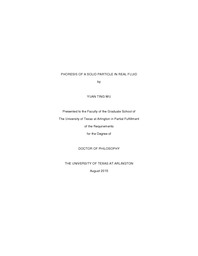
ATTENTION: The works hosted here are being migrated to a new repository that will consolidate resources, improve discoverability, and better show UTA's research impact on the global community. We will update authors as the migration progresses. Please see MavMatrix for more information.
Show simple item record
| dc.contributor.author | Wu, Yuan Ting | |
| dc.date.accessioned | 2017-05-31T19:24:10Z | |
| dc.date.available | 2017-05-31T19:24:10Z | |
| dc.date.submitted | January 2014 | |
| dc.identifier.other | DISS-12887 | |
| dc.identifier.uri | http://hdl.handle.net/10106/26691 | |
| dc.description.abstract | For micro- and nano-scale particles driven by interfacial non-contact forces in fluid, known as phoresis, this dissertation provides a general formulation and a systematic investigation. It starts with an analytical continuum-mechanics formulation that covers various important aspects of an interfacial structure, including viscosity and mass density variations as well as a body force field, in real fluid. It then reduces to specific solutions due to characteristic mechanisms. A closed-form analytical solution to the case of viscosity variation (which manifests itself as Navier's slip boundary condition) is derived. Furthermore, a novel mechanism for thermophoretic mobility driven by near-surface phase transition is introduced. It is shown that when a particle adsorbs a liquid film around its surface, and when the liquid flows along the surface due to osmosis, normal vapor fluxes in and out of the liquid film are generated. It can result in a term of thermophoretic motility inversely scaled with particle size, in contrast to classical terms with a scaling law either constant or linear with particle size. It means that this new mechanism can be powerful, especially to propel nanoparticles, as demonstrated numerically with the water-steam system modeled by using a continuum equation of state. Last, the interfacial structure of water at a solid surface is examined by using molecular dynamics simulation. It reveals interesting features that are not predicted by the above equation-of-state approach, especially in the case of a hydrophilic surface where water strongly interacts with the surface. For example, there appears to be significant anisotropic pressure in the interfacial zone, which relates to the interfacial tension. It is shown that the thermophoretic mobility due to the anisotropic pressure is as important as that of interfacial body forces with the same scaling law. | |
| dc.description.sponsorship | Yang, Bo | |
| dc.language.iso | en | |
| dc.publisher | Mechanical Engineering | |
| dc.title | Phoresis Of A Solid Particle In Real Fluid | |
| dc.type | Ph.D. | |
| dc.contributor.committeeChair | Yang, Bo | |
| dc.degree.department | Mechanical Engineering | |
| dc.degree.discipline | Mechanical Engineering | |
| dc.degree.grantor | University of Texas at Arlington | |
| dc.degree.level | doctoral | |
| dc.degree.name | Ph.D. | |
Files in this item
- Name:
- Wu_uta_2502D_12887.pdf
- Size:
- 2.713Mb
- Format:
- PDF
This item appears in the following Collection(s)
Show simple item record


